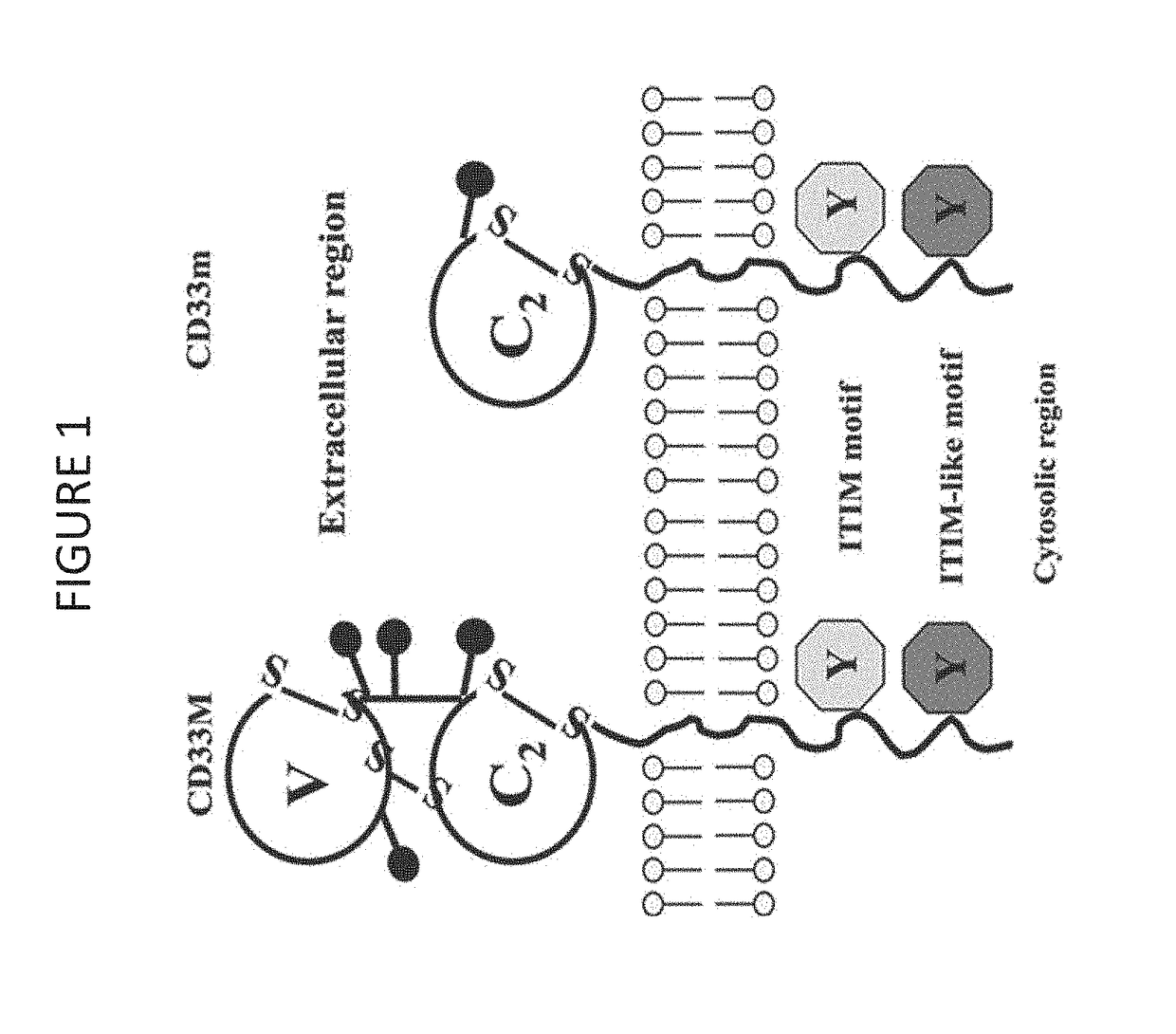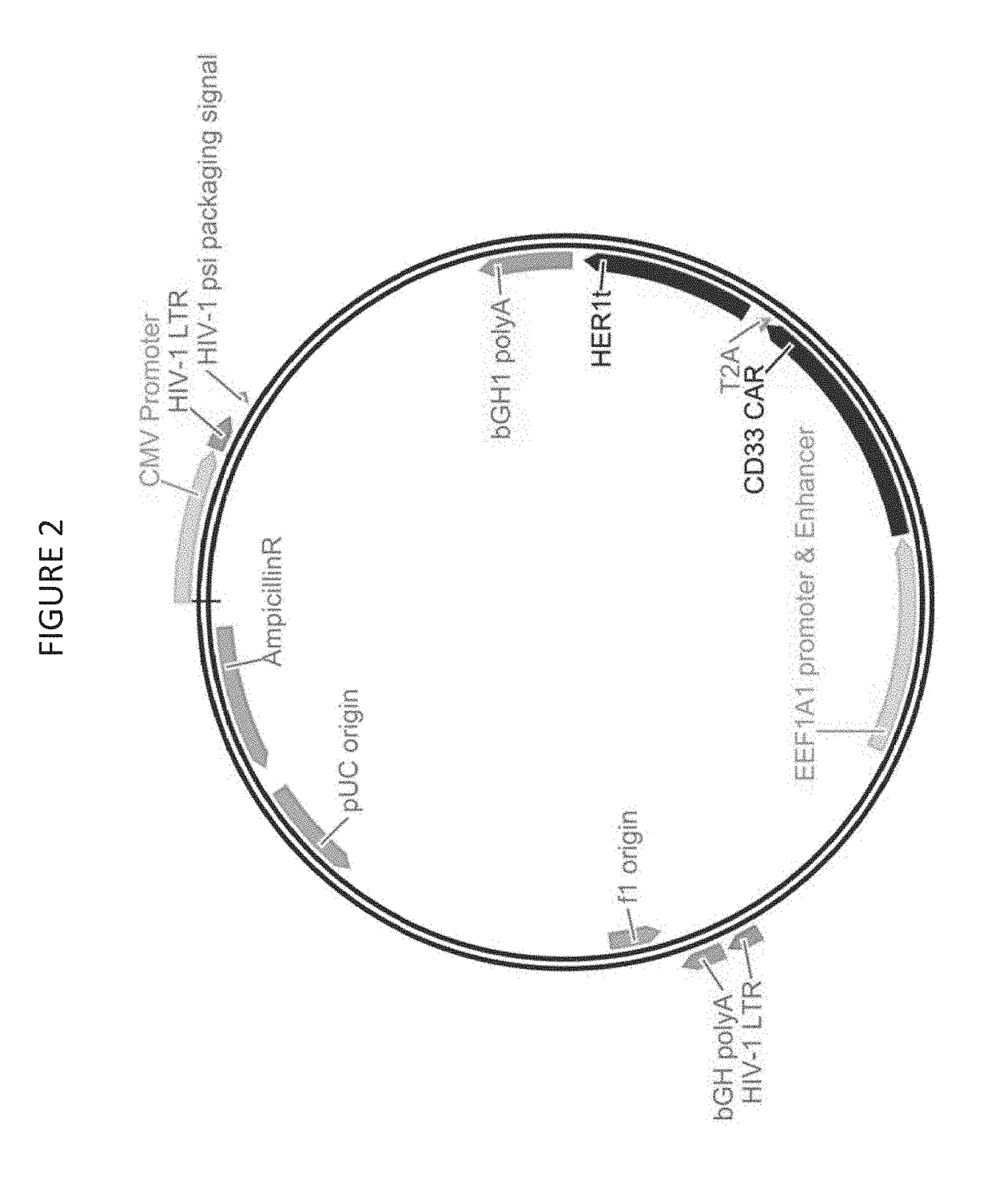Cd33 specific chimeric antigen receptors
a chimeric antigen receptor and cd33 technology, applied in the field of cd33 specific chimeric antigen receptors and vectors, can solve the problems of poor tolerability and treatment outcomes, high rates of treatment-related mortality, and limited treatment options for aml patients, and achieve the effect of stimulating the proliferation and/or survival of engineered t-cells
- Summary
- Abstract
- Description
- Claims
- Application Information
AI Technical Summary
Benefits of technology
Problems solved by technology
Method used
Image
Examples
example 1
[0324]Delivery of CD33 CAR via Lentiviral Vector. CD33 CAR lentiviral vector was constructed based on a HIV-1 derived vector backbone. The HER1t gene was genetically fused to the CD33 CAR at 3′ end via in-frame self-cleaving Thosea asigna virus 2A peptide (T2A). Both genes were cloned into the pFUGW lentiviral plasmid backbone as described below.
[0325]For CD33 CAR lentivirus, VSV-G (glycoprotein of the vesicular stomatitis virus (VSV-G)) was used as a substitute for the HIV-1 envelope proteins resulting in improved vector stability, target cell tropism, and transduction efficiency (Cronin, J., Zhang, X. & Reiser, J., Altering the tropism of lentiviral vectors through pseudotyping, Curr Gene Ther. 5(4):387-98 (2005)).
[0326]During production, CD33 CAR viral particles assembled and bud out from the surface of transfected HEK293T cells. The VSV-G protein was provided by the pMND-VSVG helper plasmid, the vector core and enzyme proteins were provided by the pΔ8.9 so (GagPol) helper plasmi...
example 2
[0330]Methods of Making CD33 CAR Vector
[0331]LV-CD33 CAR vector was assembled from three sources:
[0332](1) The following were obtained from a previously constructed vector, digested with restriction enzymes PacI and BlpI:[0333](a) pFUGW backbone components[0334](b) A human elongation factor 1 alpha 1 promoter (EF1A1) promoter and enhancer driving the anti-CD33 scFv with GM-CSFR alpha signal peptide[0335](c) The CD8a hinge and transmembrane regions.
[0336](2) The 4-1BB signaling domain module was obtained as synthetic gene.
[0337](3) A region containing CD3. T2A transcription linker, GM-CSFR alpha signal peptide, HER1t depletion marker, bovine growth hormone polyA, and flanking cloning sites was amplified by PCR.
[0338]The three DNA cassettes were annealed together in an in vitro assembly reaction, using homology regions provided to each cassette. Resulting lentiviral vector contained transgenes of interest (CD33 CAR and HER1t) in the reverse orientation with respect to lentiviral genom...
example 3
Delivery System Efficiency
[0342]Transduction of T cells from healthy donors with LV-CD33 CAR lentiviral vector typically resulted in 25-50% cells stably co-expressing CD33 CAR and HER1t at 12-14 days post transduction. FIG. 4 describes typical lentiviral transduction schematic for generation of CAR-T cells. FIG. 5 shows representative data of CD33 CAR and HER1t expression at 12 days post lentiviral transduction from one healthy donor T cells. Purified human CD3+ T cells were activated using Dynabeads® Human T-Activator CD3 / CD28 beads prior to transduction with CD33 CAR lentiviral vector at a multiplicity of infection (MOI) of 5. Cells were grown in medium containing IL-2 for 12 days post transduction. Flow cytometric analysis was performed 12 days post transduction to assess CD33 CAR and HER1t expression as measured by protein L and cetuximab mAb, respectively.
[0343]FIG. 6 confirms CD33 CAR expression from lentivirally transduced cells by Western Blot. Expanded untransduced or lenti...
PUM
| Property | Measurement | Unit |
|---|---|---|
| time | aaaaa | aaaaa |
| time period | aaaaa | aaaaa |
| time period | aaaaa | aaaaa |
Abstract
Description
Claims
Application Information
 Login to View More
Login to View More - R&D
- Intellectual Property
- Life Sciences
- Materials
- Tech Scout
- Unparalleled Data Quality
- Higher Quality Content
- 60% Fewer Hallucinations
Browse by: Latest US Patents, China's latest patents, Technical Efficacy Thesaurus, Application Domain, Technology Topic, Popular Technical Reports.
© 2025 PatSnap. All rights reserved.Legal|Privacy policy|Modern Slavery Act Transparency Statement|Sitemap|About US| Contact US: help@patsnap.com



